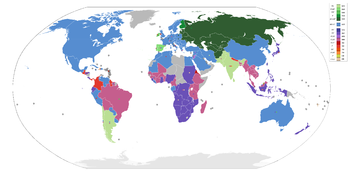
Rail gauge in South America
Encyclopedia

Argentina
Rail transport in Argentina
The Argentine railway network comprised of track at the end of the Second World War and was, in its time, one of the most extensive and prosperous in South America. However, with the increase in highway construction, there followed a sharp decline in railway profitability, leading to the break-up...
and Chile use "Indian gauge
Indian gauge
Indian gauge is a track gauge commonly used in India, Pakistan, Bangladesh, Sri Lanka, Argentina and Chile. It is also the gauge that is used on BART , in northern California.- Scotland :...
" as well as .
Brazil
Rail transport in Brazil
Rail transport in Brazil began in the 19th century and there were many different railway companies. The railways were nationalised under RFFSA in 1957...
uses (known as "Irish gauge
Irish gauge
Irish gauge railways use a track gauge of . It is used in* Ireland * Australia where it is also known as Victorian Broad Gauge* Brazil where it is also known as Bitola larga no Brasil....
", most common for passenger services and a few corridors in the Southeast) and (known as "narrow gauge" or "metre gauge
Metre gauge
Metre gauge refers to narrow gauge railways and tramways with a track gauge of . In some African, American and Asian countries it is the main gauge. In Europe it has been used for local railways in France, Germany, and Belgium, most of which were closed down in mid 20th century. Only in Switzerland...
", most common for cargo
Cargo
Cargo is goods or produce transported, generally for commercial gain, by ship, aircraft, train, van or truck. In modern times, containers are used in most intermodal long-haul cargo transport.-Marine:...
services). Exceptions are the Estrada de Ferro do Amapá North of the River Amazon, which has gauge and the new Line 5 of São Paulo Metro
São Paulo Metro
The São Paulo Metro is the principal rapid-transit system in the city of São Paulo and the largest in Brazil. It is also the second largest system in South America and the third largest in Latin America, behind Mexico City and Santiago....
, which also uses standard gauge.
Argentina (partly), Paraguay
Rail transport in Paraguay
The Rail system in Paraguay consisted primarily of a 376 km main line of standard gauge between Asunción and Encarnación . The infrastructure was administered by Ferrocarriles del Paraguay S.A. , corporation established in 2002...
, Uruguay
Rail transport in Uruguay
The Uruguayan railway network has approximately 2900 km of lines, all of gauge 1435 mm, diesel traction and only 11 km of double track...
and Peru
Rail transport in Peru
Rail transport in Peru has never consisted of a true network, primarily comprising separate lines running inland from the coast.Many of the lines owe their origins to contracts granted to United States entrepreneurs Henry Meiggs and W. R. Grace and Company but the mountainous nature of Peru made...
use standard gauge
Standard gauge
The standard gauge is a widely-used track gauge . Approximately 60% of the world's existing railway lines are built to this gauge...
. In the past a few lines in Northern Chile also had standard gauge, as the only international railway between Arica (Chile) and Tacna (Peru) a bit more than 60 km has standard gauge. The El Cerrejón Coal Railway in Colombia
Rail transport in Colombia
The Colombia railway network has a total length of 3,304 km. There are 150 km of standard gauge connecting Cerrejón coal mines to maritime port of Puerto Bolivar at Bahia de Portete, and 3,154 km of narrow gauge of which 2,611 km are in use...
and the Venezuelan Railways are also .
There are and were also some lines using different narrow gauges, see the "narrow gauge" section in List of rail gauges#Uncommon or obsolete gauges

